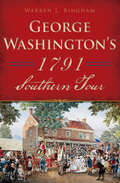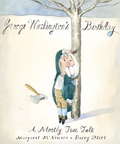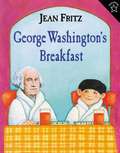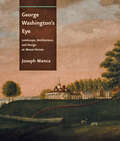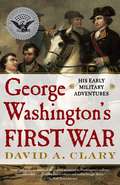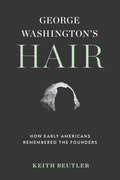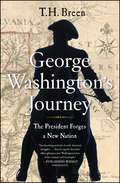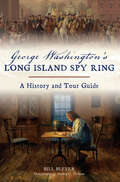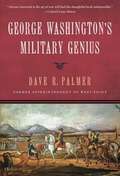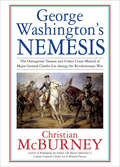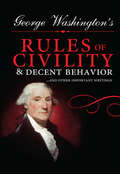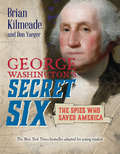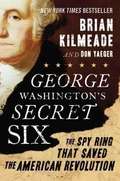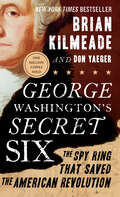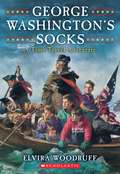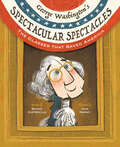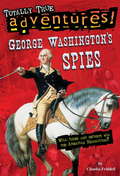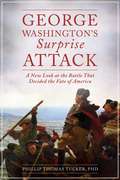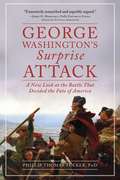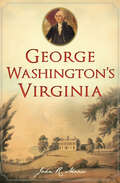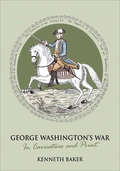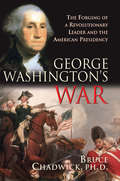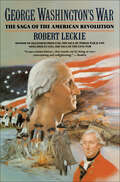- Table View
- List View
George Washington's 1791 Southern Tour (History And Guide Ser.)
by Warren L. BinghamThis account of the first president&’s trip to unite a young America &“follows Washington&’s travels day-by-day with detailed information about each stop&” (Daily Herald). Newly elected president George Washington set out to visit the new nation aware that he was the singular unifying figure in America. The journey&’s finale was the Southern Tour, begun in March 1791. The long and arduous trek from the capital, Philadelphia, passed through seven states and the future Washington, DC. But the focus was on Virginia, the Carolinas, and Georgia. The president kept a rigorous schedule, enduring rugged roads and hazardous water crossings. His highly anticipated arrival in each destination was a community celebration with countless teas, parades, dinners, and dances. Author Warren Bingham reveals the history and lore of the most beloved American president and his survey of the newly formed southern United States. Includes photos
George Washington's Birthday: A Mostly True Tale
by Margaret Mcnamara Barry BlittFrom award-winning author Margaret McNamara and New Yorker artist Barry Blitt comes this partly true and completely funny story of George Washington's 7th birthday. In this clever approach to history, readers will discover the truths and myths about George Washington. Did George Washington wear a wig? No. Did George Washington cut down a cherry tree? Probably not. Readers young and old who are used to seeing George Washington as an old man, will get a new look at the first president--as a kid. Perfect for classrooms, Presidents' Day, or as a birthday gift.From the Hardcover edition.
George Washington's Breakfast
by Jean FritzGeorge Washington Allen, a boy who never gives up until he finds out what he wants to know, is determined to learn all there is to know about his namesake.
George Washington's Eye: Landscape, Architecture, and Design at Mount Vernon
by Joseph MancaExplore the beauty and history of Mount Vernon—and the inquisitive, independent mind of its famous architect and landscape designer.Winner of the John Brinkerhoff Jackson Book Prize of the Foundation for Landscape ArchitectureOn the banks of the Potomac River, Mount Vernon stands, with its iconic portico boasting breathtaking views and with a landscape to rival the great gardens of Europe, as a monument to George Washington’s artistic and creative efforts. More than one million people visit Mount Vernon each year—drawn to the stature and beauty of Washington’s family estate.Art historian Joseph Manca systematically examines Mount Vernon—its stylistic, moral, and historical dimensions—offering a complete picture of this national treasure and the man behind its enduring design. Manca brings to light a Washington deeply influenced by his wide travels in colonial America, with a broader architectural knowledge than previously suspected, and with a philosophy that informed his aesthetic sensibility. Washington believed that design choices and personal character mesh to form an ethic of virtue and fulfillment and that art is inextricably linked with moral and social concerns. Manca examines how these ideas shaped the material culture of Mount Vernon.Based on careful study of Washington’s personal diaries and correspondence and on the lively accounts of visitors to his estate, this richly illustrated book introduces a George Washington unfamiliar to many readers—an avid art collector, amateur architect, and leading landscape designer of his time.
George Washington's First War
by David A. Clary"I heard the bullets whistle, and, believe me, there is something charming in the sound." So said the young George Washington, something no veteran soldier would say. He had not been the target of enemy fire. Instead, he was papering over the fact that his men and Indian allies had just massacred a diplomatic party, setting off the French and Indian War of 1754-63. He had violated international law, something else he would not admit. Washington could, after all, tell a lie. That is but one revelation that acclaimed military historian and Washington expert David A. Clary offers in George Washington's First War. Washington spent his adolescence in military service, starting as a colonel in command at the age of twenty-two. He came from a society without a military tradition, and had no training or battle-wise sergeants to keep him out of trouble. He was a young glory hound thrust into circumstances he was not prepared to handle by elders who should have known better. Leading reluctant amateur soldiers against French professionals, when he took command he was on his own. Accordingly, Washington survived a five-year ordeal unlike that endured by any other Founding Father. He emerged from it not yet the steady supreme commander of the Revolution, but he had started on the road that led him to become the great soldier and statesman of his age. How he began his life's journey is what George Washington's First War is about. It is a dramatic story of frontier warfare played out against the anxieties and resentments of an ambitious adolescent. Here are accounts of harrowing ordeals in the wilderness, the decisive part played by the Indian nations whose continent this was, and the epic clash of empires. Others have looked at Washington's activities during the French and Indian War without recognizing that he played his part in that history during his painful transition from boy to man. His repeated blunders and defeats arose from his youthful impetuosity and inexperience and weak support from his government. Clary has a sound understanding of eighteenth-century wilderness warfare, and his descriptions of battles are vivid, exciting, and laced with horrifying details. Brought to dramatic life are Washington's harrowing wintertime journey into the wilderness to order the French to leave the territory, the Jumonville Massacre, his bloody defeat at Fort Necessity, his heroism at the Battle of the Monongahela (Braddock's Defeat), his years of frustration commanding the Virginia Regiment, the Forbes Expedition of 1758, his insubordination to civil and military superiors, and his resignation from the army. A revealing portrait of Washington during a crucial, formative period of his life, this is the indispensable backstory to the making of a great man.
George Washington's Hair: How Early Americans Remembered the Founders
by Keith BeutlerMostly hidden from public view, like an embarrassing family secret, scores of putative locks of George Washington’s hair are held, more than two centuries after his death, in the collections of America’s historical societies, public and academic archives, and museums. Excavating the origins of these bodily artifacts, Keith Beutler uncovers a forgotten strand of early American memory practices and emerging patriotic identity.Between 1790 and 1840, popular memory took a turn toward the physical, as exemplified by the craze for collecting locks of Washington’s hair. These new, sensory views of memory enabled African American Revolutionary War veterans, women, evangelicals, and other politically marginalized groups to enter the public square as both conveyors of these material relics of the Revolution and living relics themselves. George Washington’s Hair introduces us to a taxidermist who sought to stuff Benjamin Franklin’s body, an African American storyteller brandishing a lock of Washington’s hair, an evangelical preacher burned in effigy, and a schoolmistress who politicized patriotic memory by privileging women as its primary bearers. As Beutler recounts in vivid prose, these and other ordinary Americans successfully enlisted memory practices rooted in the physical to demand a place in the body politic, powerfully contributing to antebellum political democratization.
George Washington's Journey
by T. H. BreenThis is George Washington in the surprising role of political strategist.T.H. Breen introduces us to a George Washington we rarely meet. During his first term as president, he decided that the only way to fulfill the Revolution was to take the new federal government directly to the people. He organized an extraordinary journey carrying him to all thirteen states. It transformed American political culture. For Washington, the stakes were high. If the nation fragmented, as it had almost done after the war, it could never become the strong, independent nation for which he had fought. In scores of communities, he communicated a powerful and enduring message--that America was now a nation, not a loose collection of states. And the people responded to his invitation in ways that he could never have predicted.s us on these journeys. We see the country through Washington's eyes and listen through his ears. We understand why George Washington is the indispensable Founding Father.
George Washington's Long Island: A History and Tour Guide (History & Guide)
by Bill BleyerIn 1778, two years after the British forced the Continental Army out of New York City, George Washington and his subordinates organized a secret spy network to gather intelligence in Manhattan and Long Island. Known today as the "Culper Spy Ring," Patriots like Abraham Woodhull and Robert Townsend risked their lives to report on British military operations in the region. Vital reports clandestinely traveled from New York City across the East River to Setauket and were rowed on whaleboats across the Long Island Sound to the Connecticut shore. Using ciphers, codes and invisible ink, the spy ring exposed British plans to attack French forces at Newport and a plot to counterfeit American currency. Author Bill Bleyer corrects the record, examines the impact of George Washington's Long Island spy ring and identifies Revolutionary War sites that remain today.
George Washington's Military Genius
by Dave Richard PalmerGeorge Washington's military strategy has been called bumbling at worst and brilliant at best. So which is it? Was George Washington a strategic genius or just lucky? So asks Dave R. Palmer in his new book, George Washington's Military Genius. An updated edition of Palmer's earlier work, The Way of the Fox, George Washington's Military Genius breaks down the American Revolution into four phases and analyzes Washington's strategy during each phrase. "The British did not have to lose; the patriots did not have to triumph," writes Palmer as he proves without a doubt that Washington's continuously-changing military tactics were deliberate, strategic responses to the various phases of the war, not because he lacked a plan of action. Confronting the critics who say Washington's battlefield success and ultimate victories were a function of luck, George Washington's Military Genius proves why the father of our country also deserves the title of America's preeminent strategist.
George Washington's Mother
by Jean FritzThis biography introduces young readers to the mother of George Washington--showing him in a more human light.
George Washington's Nemesis: The Outrageous Treason and Unfair Court-Martial of Major General Charles Lee during the Revolutionary War
by Christian McBurneyThis biography attempts to set the record straight for a misunderstood military figure from the American Revolution. Historians and biographers of Charles Lee have treated him as either an enemy of George Washington or a defender of American liberty. Neither approach is accurate; objectivity is required to fully understand the war&’s most complicated general. In George Washington&’s Nemesis, author Christian McBurney uses original documents (some newly discovered) to combine two dramatic stories to create one balanced view of one of the Revolutionary War&’s most fascinating personalities. General Lee, second in command in the Continental Army led by George Washington, was captured by the British in December, 1776. While imprisoned, he gave his captors a plan on how to defeat Washington&’s army as quickly as possible. This extraordinary act of treason was not discovered during his lifetime. Less well known is that throughout his sixteen months of captivity and even after his release, Lee continued communicating with the enemy, offering to help negotiate an end to the rebellion. After Lee rejoined the Continental Army, he was given command of many of its best troops together with orders from Washington to attack British general Henry Clinton&’s column near Monmouth, New Jersey. But things did not go as planned for Lee, leading to his court-martial for not attacking and for retreating in the face of the enemy. McBruney argues the evidence clearly shows Lee was unfairly convicted and had, in fact, done something beneficial. But Lee had insulted Washington, which made the matter a political contest between the army&’s two top generals—only one of whom could prevail.
George Washington's Rules of Civility & Decent Behavior
by George Washington"Labour to keep alive in your breast that little celestial fire called conscience. ""Run not in the streets. . . nor with mouth open; go not upon the toes nor in a dancing fashion. "George Washington was known as a remarkably modest and courteous man. Humility and flawless manners were so ingrained in his character that he rarely if ever acted without them. The "Rules of Civility and Decent Behavior" that governed Washington's etiquette were by turns practical, inspirational and curious. These rules are as instructive and invaluable today as they were hundreds of years ago. George Washington's Rules of Civility and Decent Behavior includes the complete text of the rules, as well as famous Washington writings such as:-Farewell to the Armies speech-Inaugural Address-Retirement Address-Address at the End of His Presidency
George Washington's Secret Six (Young Readers Adaptation): The Spies Who Saved America
by Brian Kilmeade Don YaegerA page-turning middle-grade adaptation of the New York Times bestseller about George Washington's top-secret spy ring that helped defeat the British.The American Revolution is well under way in 1776, but things are looking bleak for General George Washington and his Continental Army. With Washington's hasty retreat from New York City in August, many think the war might soon be over. After all: how on earth is this ragtag group going to defeat its enemy, the well-trained and well-funded military of the largest empire in history? But Washington soon realizes he can't win with military might. Instead, he must outsmart the British, so he creates a sophisticated intelligence network: the top-secret Culper Spy Ring. Drawing on extensive research, Brian Kilmeade and Don Yaeger tell the fascinating stories of these long unrecognized spies: a reserved merchant, a tavern keeper, a brash young longshoreman, a curmudgeonly Long Island bachelor, a coffeehouse owner, and a mysterious woman.This vivid and accessible young readers adaptation of the New York Times bestseller features an exclusive new introduction, extensive back matter, and eye-catching art throughout. Chronicling a crucial moment in American history, this historical thriller will excite and inspire the next generation of patriots.
George Washington's Secret Six: The Spy Ring That Saved The American Revolution
by Brian Kilmeade Don Yaeger"As a Long Islander endlessly fascinated by events that happened in a place I call home, I hope with this book to give the secret six the credit they didn't get in life. The Culper spies represent all the patriotic Americans who give so much for their country but, because of the nature of their work, will not or cannot take a bow or even talk about their missions. "--Brian Kilmeade When General George Washington beat a hasty retreat from New York City in August 1776, many thought the American Revolution might soon be over. Instead, Washington rallied--thanks in large part to a little-known, top-secret group called the Culper Spy Ring. Washington realized that he couldn't beat the British with military might, so he recruited a sophisticated and deeply secretive intelligence network to infiltrate New York. So carefully guarded were the members' identities that one spy's name was not uncovered until the twentieth century, and one remains unknown today. But by now, historians have discovered enough information about the ring's activities to piece together evidence that these six individuals turned the tide of the war. Drawing on extensive research, Brian Kilmeade and Don Yaeger have painted compelling portraits of George Washington's secret six: Robert Townsend, the reserved Quaker merchant and reporter who headed the Culper Ring, keeping his identity secret even from Washington; Austin Roe, the tavern keeper who risked his employment and his life in order to protect the mission; Caleb Brewster, the brash young longshoreman who loved baiting the British and agreed to ferry messages between Connecticut and New York; Abraham Woodhull, the curmudgeonly (and surprisingly nervous) Long Island bachelor with business and family excuses for traveling to Manhattan; James Rivington, the owner of a posh coffeehouse and print shop where high-ranking British officers gossiped about secret operations; Agent 355, a woman whose identity remains unknown but who seems to have used her wit and charm to coax officers to share vital secrets. In" George Washington's Secret Six," Townsend and his fellow spies finally receive their due, taking their place among the pantheon of heroes of the American Revolution.
George Washington's Secret Six: The Spy Ring That Saved the American Revolution
by Brian Kilmeade Don Yaeger*Now with a new afterword containing never-before-seen research on the identity of the spy ring’s most secret member, Agent 355“This is my kind of history book. Get ready. Here’s the action.” —BRAD MELTZER, bestselling author of The Fifth Assassin and host of DecodedWhen George Washington beat a hasty retreat from New York City in August 1776, many thought the American Revolution might soon be over. Instead, Washington rallied—thanks in large part to a little-known, top-secret group called the Culper Spy Ring. He realized that he couldn’t defeat the British with military might, so he recruited a sophisticated and deeply secretive intelligence network to infiltrate New York.Drawing on extensive research, Brian Kilmeade and Don Yaeger have offered fascinating portraits of these spies: a reserved Quaker merchant, a tavern keeper, a brash young longshoreman, a curmudgeonly Long Island bachelor, a coffeehouse owner, and a mysterious woman. Long unrecognized, the secret six are finally receiving their due among the pantheon of American heroes.
George Washington's Secret Spy War: The Making of America's First Spymaster
by John A. NagyThis “fast-paced chronicle reveals a little-known side of America’s Revolutionary War hero”—and how intelligence helped him defeat the British (Publishers Weekly).Here is the untold story of how George Washington used his skills as a spymaster to win the Revolutionary War. Author John A. Nagy has become the nation’s leading expert on the subject, discovering hundreds of spies who went behind enemy lines to gather intelligence during the American Revolution, many of whom are completely unknown to most historians.Drawing on Washington’s personal diaries, Nagy recounts how he honed his intelligence gathering skills during the French and Indian War. He later depended on those skills as he faced a well-trained, better-equipped fighting force in the Revolutionary War. Espionage was Washington’s secret weapon, and he exploited it to extraordinary effect.Filled with thrilling and never-before-told stories from the battlefield and behind enemy lines, this is the story of how Washington out-spied the British. For the first time, readers will discover how espionage played a major part in the American Revolution and why Washington was a master at orchestrating it.
George Washington's Socks
by Elvira WoodruffThrough encounters with Hessian soldiers, revolutionaries, and even George Washington himself, Matthew, Quentin, Hooter, Tony, and Katie watch history unfold before their eyes as they see first-hand the grim realities of war and learn the cost of their freedom.
George Washington's Spectacular Spectacles: The Glasses That Saved America
by Selene CastrovillaDid you know that George Washington had a secret? He wore glasses! While initially embarrassed by his reliance on this reading aid, Washington&’s spectacles proved to be nothing short of spectacular in this charming, funny, and little-known picture book story from American history.The Revolutionary War was over, but Washington&’s officers had not received their wages from the Continental Congress in years. Afraid they would never get their money, the officers planned to storm Congress and demand it right away. Luckily, George Washington found out about the plot just in time. He delivered a passionate speech to his men, but they were unaffected. It was only when he struggled to read aloud a letter from Congress and had to put on his glasses, that they realized how much he had sacrificed for their country along with them. The officers dropped their plan and pledged their loyalty to America and to Washington.Selene Castrovilla&’s carefully researched yet playful prose and Jenn Harney&’s energetic, original illustrations bring George Washington&’s more human side to life in this humorous but important story about true American loyalty.
George Washington's Spies (Totally True Adventures)
by Claudia FriddellThink you know everything about Washington? Think again. During the Revolutionary War, General George Washington (AKA "Agent 711") was the leader of a ring of spies! The group--called the Culper Ring--used secret names, codes, invisible ink, and more to spy on the British and pass along information. Nobody knew about it at the time (and few do so today), but those sneaky heroes risked their lives to help win the American Revolution! <P><P> Illustrated throughout in black and white, with an appendix that includes photographs, bonus content, and links to primary source materials, this Totally True Adventures series book is ideal for supporting the Common Core State Standards and today's renewed interest in nonfiction. It's a thrilling read--made even better because it really happened!
George Washington's Surprise Attack
by Phillip Thomas TuckerLike many historical events, the American Revolution is sometimes overlooked, ignored, or minimized by historians due to being shrouded in romantic myth and stubborn stereotypes. Here historian Phillip Thomas Tucker provides an in-depth look at the events of the Battle of Trenton, weeding out fiction and legend and presenting new insights and analysis. Stories from many forgotten individuals of the war, including officers and soldiers from both sides, bring to life the Continental army's desperate circumstances and shocking victory. Myths that Tucker debunks include the Hessians' slovenly drunkenness, Washington acting alone in creating the attack strategy, and Rall's incompetence as a leader contributing widely to his troops' defeat.By exploring the forgotten aspects of one of America's most famous battles, Trenton's story proves to be even more revealing and fascinating. In the end, America's founding was nothing short of miraculous, and no chapter of America's story was more miraculous than Washington's improbable success at the battle of Trenton, where America's fate was decided to almost everyone's amazement on a dark, snowy morning.
George Washington's Surprise Attack: A New Look at the Battle That Decided the Fate of America
by Phillip Thomas TuckerExtensively researched and superbly argued in Tucker’s compelling narrative, this in-depth examination of George Washington’s 'military miracle’ at the Battle of Trenton unquestionably confirms the vital importance of that stunning victory.” -Jerry D. Morelock, PhD, editor in chief at Armchair GeneralLike many historical events, the American Revolution is sometimes overlooked, ignored, or minimized by historians because of common shrouding in romantic myth or interference from stubborn stereotypes. Here historian Phillip Thomas Tucker provides an in-depth look at the events of the Battle of Trenton, weeding out fiction and legend and presenting new insights and analysis. Stories from many forgotten individuals of the war, including officers and soldiers from both sides, bring to life the Continental Army’s desperate circumstances and shocking victory. Myths that Tucker debunks include the Hessians’ slovenly drunkenness, Washington acting alone in creating the attack strategy, and Rall’s incompetence as a leader largely contributing to his troops’ defeat.By exploring the forgotten aspects of one of America’s most famous battles, revealing Trenton’s story proves to be even more fascinating. In the end, America’s founding was nothing short of miraculous, and no chapter of America’s story was more miraculous than Washington’s improbable success at the battle of Trenton, where America’s fate was decided to almost everyone’s amazement on a dark, snowy morning.Skyhorse Publishing, as well as our Arcade imprint, are proud to publish a broad range of books for readers interested in history--books about World War II, the Third Reich, Hitler and his henchmen, the JFK assassination, conspiracies, the American Civil War, the American Revolution, gladiators, Vikings, ancient Rome, medieval times, the old West, and much more. While not every title we publish becomes a New York Times bestseller or a national bestseller, we are committed to books on subjects that are sometimes overlooked and to authors whose work might not otherwise find a home.
George Washington's Virginia (History And Guide Ser.)
by John R. MaassGeorge Washington slept, worked, and fought here . . . A historian&’s guide to Virginia sites and landmarks associated with the Founding Father. Born in the Tidewater region, George Washington was reared near Fredericksburg and took up residence at Mount Vernon along the Potomac River. As a young surveyor, he worked in Virginia&’s backcountry. He began his military career as a Virginia militia officer on the colony&’s frontier. The majority of his widespread landholdings were there—and his entrepreneurial endeavors ranged from the swamplands of the Southeast to the upper Potomac River Valley. In this book, historian John R. Maass explores the numerous sites all over the Commonwealth associated with Washington—and demonstrates their lasting importance. Includes photos and illustrations
George Washington's War: In Caricature and Print
by Kenneth BakerA Revolutionary War history told through eighteenth-century illustrations: &“Utterly absorbing&” (The Times, London). Americans are steeped in the history of the American Revolution, but often the fog of myth shrouds the reality. In these pages, the path to war is starkly documented by British caricatures of politicians and generals—for the most part favorable to the Colonists. For George III, Lord North, and Britain, the war was a disaster that need not have happened. The problems of coping with a country five thousand miles away with a tradition of representative government, a free press, and a spirit of independence were just too much. But they, together with Generals Howe, Burgoyne, Cornwallis, and others, were mercilessly lampooned. Washington, the hero, is spared, although there are surprising and dark elements to the American victory illustrated here. Using prints and caricatures from the period—some never before published—and drawing on his own experience in politics, Kenneth Baker provides vivid and memorable images that illustrate these extraordinary historical events.
George Washington's War: The Forging of a Revolutionary Leader and the American Presidency
by Bruce ChadwickDrawing on archival and other sources, Chadwick (American history, Rutgers U.) offers a new perspective on the well-known story of the plight of General Washington and his men at Valley Forge. He argues that the future president developed a model of leadership for dealing with national emergencies when he campaigned to secure emergency supplies for his troops. Includes period illustrations. Annotation ©2004 Book News, Inc., Portland, OR (booknews.com)
George Washington's War: The Saga of the American Revolution
by Robert Leckie“Exciting accounts of the major campaigns [of the American Revolution] . . . a reminder of what history can be when written by a master.” —Publishers Weekly“Beginning with a recapitulation of the French and Indian War—which, though ending in British victory, represented the beginning of the end of the British empire in America—[Robert] Leckie briskly recounts the well-known events leading to America’s break with Britain and the military development of the war. In anecdotal biographical sketches, he draws vivid portraits of the war’s principals: George III, George Washington, Thomas Gage, Lord Cornwallis, and Benedict Arnold, among others. Leckie summarizes the principal battles of the war—Lexington and Concord, Bunker Hill, Washington’s disastrous Long Island and Manhattan campaigns, his victories at Trenton, Princeton, Saratoga, and Yorktown—in lucid, workmanlike fashion. In superb depictions of the British leaders and of the British home front, he also adds details rarely found in popular American histories, and, unlike some historians, he doesn’t neglect the southern war—the battles of Camden, Cowpens, and King’s Mountain are covered as thoroughly as any.” —Kirkus Reviews“Entertaining and enlightening.” —Booklist
